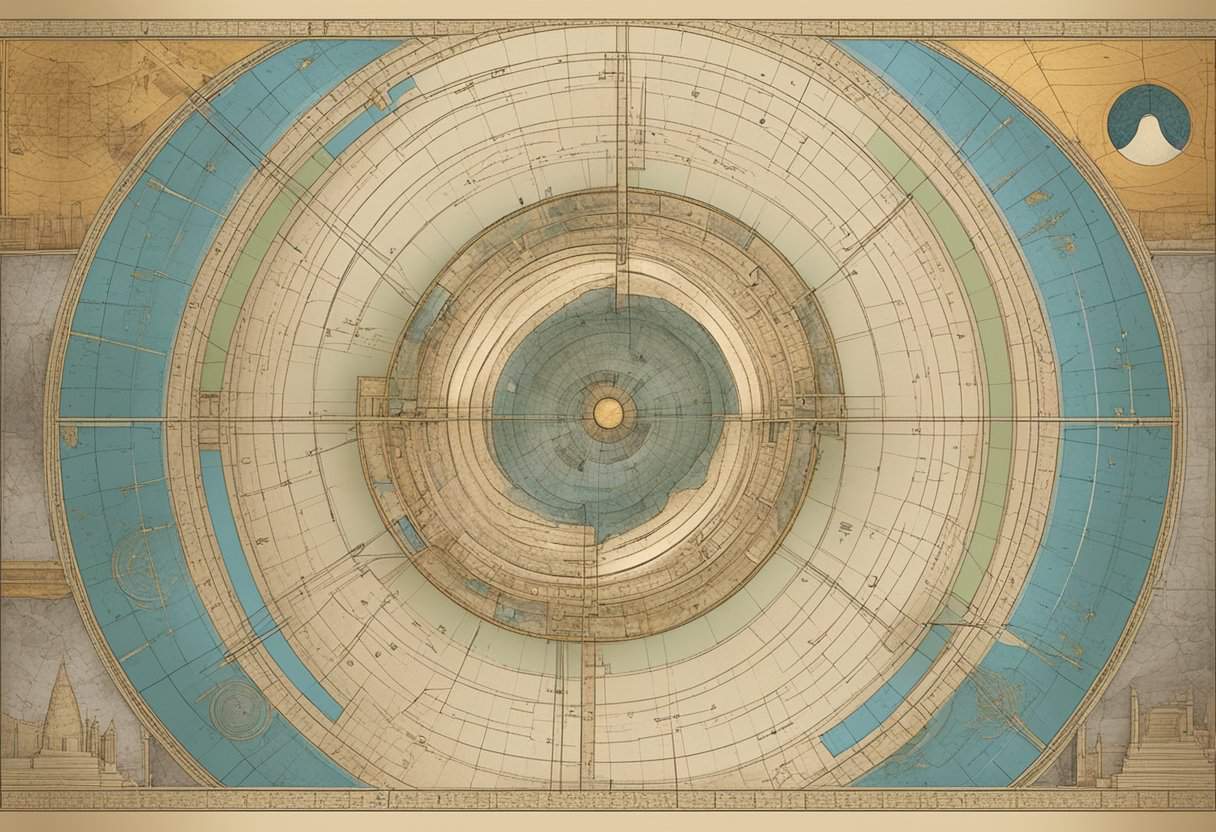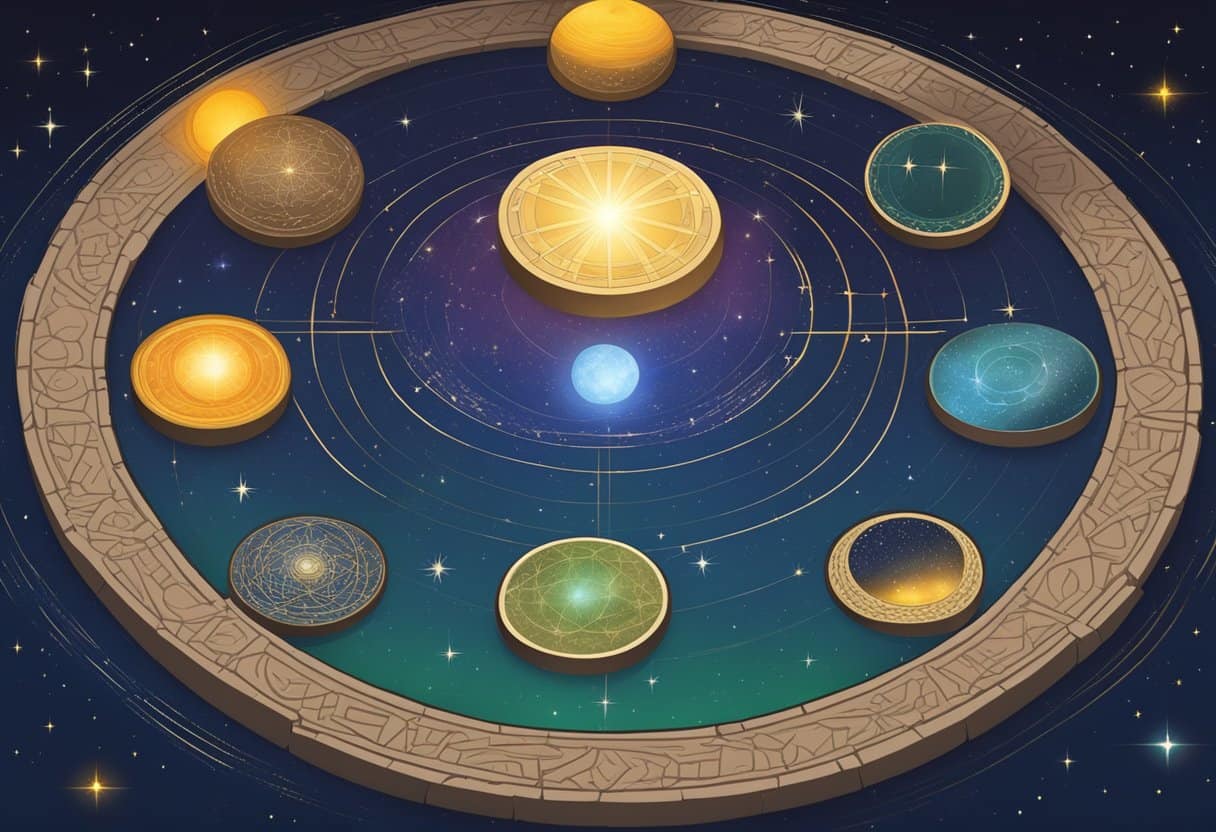Archeoastronomy is a fascinating interdisciplinary field of study that explores how people in the past have understood the phenomena in the sky and how those understandings influenced their cultures.
From the construction of monumental structures to the alignment of ancient buildings and cities, archeoastronomy offers insights into the astronomical practices and beliefs of vanished civilizations. By examining physical artifacts and archaeological sites, researchers decode the celestial knowledge and astronomical importance placed on these sites by their creators.
Throughout history, myriad cultures have left their mark under the stars through impressive and mystifying constructions. The study of these relics reveals that celestial bodies like the sun, moon, and stars often played a significant role in religious ceremonies, calendar systems, and navigation. Examples such as Stonehenge in England or the Mayan pyramids of Central America highlight the complex understanding of astronomy that ancient civilizations possessed.
By connecting archaeological findings with historical records and astronomical events, we can uncover the profound bond between ancient peoples and the sky.
Archeoastronomy explores the celestial understanding and practices of ancient cultures through structures like Stonehenge and Mayan pyramids. These sites, aligned with astronomical events, reveal the ancients’ deep sky knowledge. This field combines archaeology and astronomy, uncovering how stars and celestial movements shaped cultural, religious, and agricultural practices.
Fundamentals of Archeoastronomy
Archeoastronomy combines methodologies from fields such as anthropology, astronomy, history, and archaeology to uncover the astronomical knowledge of ancient cultures.
Conceptual Basis and Definitions
At its core, archeoastronomy is the study of how people in the past have understood the phenomena in the sky, how they used these phenomena, and what role the sky played in their cultures. It’s about connecting celestial events with various ancient structures and artifacts found worldwide. The discipline involves analyzing architectural alignments (structures built in alignment with astronomical phenomena), artifact inscriptions that depict astronomical phenomena, and ethnohistorical records (historical documentation of cultural practices) to discern ancient stargazing practices.
Historical Development
Archeoastronomy originated from the work of scholars in the 19th and early 20th centuries who noticed alignments of ancient monuments with celestial bodies. Since then, it has evolved with contributions from both historians and scientists to investigate the political and religious significance of astronomical practices. Researchers examine sites like Stonehenge or the Nasca lines to infer the astronomical understanding and intentions of their builders. It bridges the gap between ancient cultures’ empirical observations and their applied use in calendars, rituals, and navigation.
Prehistoric Monuments and Sites
Prehistoric sites often align with astronomical events, evidencing our ancestors’ advanced understanding of the cosmos. These sites not only served ceremonial purposes but also functioned as ancient observatories.
Stonehenge
You might already know Stonehenge as one of the most famous prehistoric monuments in the world. This structure, located in Wiltshire, England, is composed of a ring of standing stones, each around 13 feet high. Archaeological evidence suggests that some of these stones were positioned to align with the solstices, marking significant points in the annual solar cycle. Stonehenge’s precise purpose remains a topic of research, but its alignments indicate a sophisticated knowledge of astronomy and geometry.
Goseck Circle
The Goseck Circle, often regarded as the oldest solar observatory, is a Neolithic structure discovered in Saxony-Anhalt, Germany. Comprising a series of concentric rings created by wooden palisades, it features gates that are aligned with sunrise and sunset during the winter solstice. This remarkable ancient site likely played a crucial role in local agricultural rituals by marking the solar calendar.
Newgrange
Located in County Meath, Ireland, Newgrange is a large circular mound with a stone passageway and interior chambers. This site is approximately 5,200 years old, making it older than both Stonehenge and the Egyptian pyramids. Newgrange is notably known for its roof-box, which allows the sun to illuminate its main chamber during winter solstice sunrise — a feature that highlights the monument’s intentional design aligned with celestial events.
Ancient Architectural Alignments

When exploring the field of archaeoastronomy, you’ll find a fascinating intersection where astronomy meets ancient architecture. Key structures from historical civilizations often reflect sophisticated knowledge of celestial patterns. Here are some significant examples:
Egyptian Pyramids
The Great Pyramid of Giza, aligned with impressive precision to the cardinal points, mirrors the ancient Egyptians’ deep understanding of astronomy. The north-facing side of this pyramid closely aligns with the North Star, showing a connection to celestial bodies in their construction.
Greek Temples
The orientation of Ancient Greek Temples commonly reflects astronomical significance. For instance, the Parthenon in Athens has specific alignments to solar events. The temple’s layout is tuned with the rising sun on particular days significant to Athenian culture and the worship of goddess Athena.
Machu Picchu
The Incan city of Machu Picchu in Peru exhibits clear indicators of celestial alignment. The Intihuatana stone, when used as a solar observatory, accurately indicates the two annual equinoxes. This underscores the Incan mastery of correlating architectural design with astronomical events.
Cultural Astronomy
Cultural astronomy examines the way different societies understand the stars and skies, placing a strong emphasis on how this knowledge influences their calendars, rituals, and daily life.
Mayan Calendar Systems
The Maya civilization developed complex calendar systems intertwined with their astronomical observations. Central to this was the Tzolk’in, a 260-day cycle that was used alongside the Haab’, a 365-day vague solar year, to create a 52-Haar cycle called the Calendar Round. This tandem calendar system orchestrated much of Mayan society, dictating times for farming, festivals, and even predicting astronomical events like eclipses.
Native American Sky Lore
Native American cultures are rich with teachings where the movements of celestial bodies are not simply observed but hold deep spiritual significance. The Lakota people, for instance, refer to the constellation Pleiades as “The Seven Little Girls,” who play a vital role in signaling the coming change of seasons. Similarly, the Navajo’s ‘Dilyéhé‘ portrays the Pleiades as a marker for assessing the night’s length and determining the agricultural schedule.
Astronomical Methods in Archeology
As you explore the intersection of astronomy and archaeology, you’ll find precise methods used to comprehend past civilizations through celestial events and alignments.
Dating Techniques
Your understanding of archaeoastronomy must include the critical dating techniques employed to pinpoint the timeframes of archaeological sites. One such technique, dendrochronology, cross-references tree-ring patterns with known solar patterns to establish accurate timestamps. Also, radiocarbon dating provides age estimates by measuring radioactive decay in organic materials, which, when integrated with astronomical data, can help correlate human activity with celestial events.
Lunar and Solar Observations
Ancient civilizations were closely attuned to the rhythms of the Moon and Sun, guiding agricultural practices, religious ceremonies, and even urban planning. A notable example is the Lunar Standstill, which occurs roughly every 18.6 years and can be identified at sites like Stonehenge, where specific stones align with the Moon’s extreme positions on the horizon.
Architectural Alignment Analysis
Finally, examining the architectural alignments of ancient monuments reveals their orientation towards astronomical phenomena. Structures such as the Egyptian pyramids align with remarkable precision to cardinal points, which directly relate to sunrises and sunsets at specific times of the year. Similarly, newly developed techniques allow for a quantitative analysis of stone circles, providing evidence of intentional alignment with celestial bodies.
Frequently Asked Questions
Archeoastronomy explores the astronomical practices, celestial lore, mythologies, religions, and worldviews of past cultures. This section will answer some of the commonly asked questions about archeoastronomical sites and the science behind them.
What are some notable archeoastronomical sites found in North America?
In North America, the Sun Dagger at Fajada Butte in Chaco Canyon and the Medicine Wheel in Wyoming are well-documented for their solar and lunar alignments.
Can you list significant global landmarks that exhibit archeoastronomical properties?
Globally, landmarks such as Stonehenge in the UK, the Pyramids of Giza in Egypt, and the ancient carvings at the Venus of Laussel in France provide insight into past celestial alignments and practices.
What are some prominent examples of ancient astronomical observatories around the world?
Prominent examples of ancient observatories include the El Caracol observatory at Chichen Itza, the 13th-century Maragheh observatory in Iran, and the Jantar Mantar observatories in India.
In what ways does archeoastronomy intersect with other scientific disciplines?
Archeoastronomy bridges the gap between fields such as anthropology, archaeology, and history, by revealing how ancient societies understood the cosmos and integrated this knowledge into their cultures.
How does archeoastronomy differ from traditional astronomy in its objectives and methods?
Archeoastronomy focuses on the cultural and ritualistic aspects of astronomy, emphasizing how ancient peoples observed and interpreted the sky within their social and cultural contexts, unlike traditional astronomy, which is concerned with the objective study of celestial objects and phenomena.
What are the main reasons for the controversy surrounding archeoastronomy as a field?
The controversy stems from the interdisciplinary approach of archeoastronomy that sometimes leads to speculative interpretations without sufficient scientific evidence and the challenges in separating astronomical purpose from coincidence in ancient structures.


![Best Telescope for Deep Space Observation: Top [year] Picks](https://observationhobbies.com/wp-content/uploads/2024/01/Best-Telescope-for-Deep-Space-Observation-768x525.png)



![Best Smart Telescope: Top [year] Models for Astronomy](https://observationhobbies.com/wp-content/uploads/2024/01/Best-Smart-Telescope-768x525.png)
